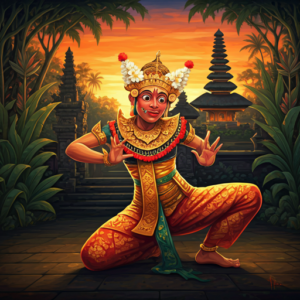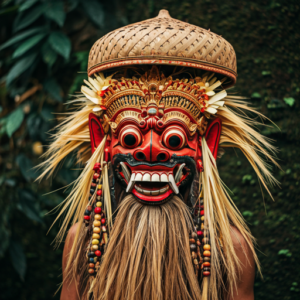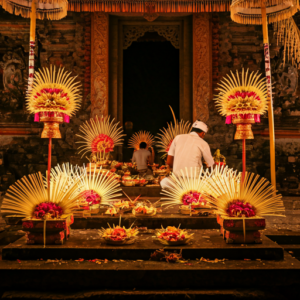
Batik, a traditional technique of wax-resist dyeing applied to cloth, is an ancient art form that holds a special place in the cultural heritage of Indonesia. While it is widely practiced across the Indonesian archipelago, Balinese batik stands out for its distinctive patterns and rich symbolism. These designs often draw from nature and mythology, reflecting the island’s deep connection to its environment and spiritual traditions. Exploring Balinese batik reveals not just a textile art but a vibrant tapestry of cultural stories and beliefs.
The Art and Technique of Batik
Batik is a complex and labor-intensive process that involves applying wax to fabric in specific patterns, then dyeing the fabric. The areas covered by wax resist the dye, allowing artisans to create intricate designs. This process can be repeated with multiple colors, with the wax being applied and removed for each new dye bath.
In Bali, batik is traditionally made using natural fibers like cotton and silk. Artisans use tools such as the canting, a small copper container with a spout to draw fine lines, and the cap, a copper stamp used for larger, repeated patterns. The dyeing process involves natural dyes made from plants, roots, and other organic materials, contributing to the unique color palette of Balinese batik.
Patterns of Nature
Nature is a predominant theme in Balinese batik, with patterns often depicting the island’s lush landscapes and diverse flora and fauna. These motifs are not just decorative but imbued with meaning and symbolism.
- Floral Motifs: Flowers are a common element in Balinese batik, symbolizing beauty, growth, and the cycle of life. Common floral patterns include the hibiscus, frangipani, and lotus. The lotus, in particular, holds spiritual significance, representing purity and enlightenment in Balinese Hinduism.
- Fauna: Animals also play a significant role in Balinese batik designs. Birds, butterflies, and fish are frequently depicted, symbolizing freedom, transformation, and prosperity. The barong, a mythical lion-like creature, often appears in batik patterns, representing protection and good fortune.
- Geometric Patterns: In addition to natural motifs, Balinese batik includes geometric designs that mimic natural forms. These patterns, such as spirals, waves, and interlocking shapes, reflect the island’s volcanic origins and the flow of water, both essential elements of Balinese life.
Mythological Themes
Balinese culture is deeply rooted in mythology and spiritual beliefs, which are richly represented in batik patterns. These designs tell stories from Hindu epics, local legends, and religious rituals, weaving a narrative tapestry that connects the wearer to their cultural heritage.
- Ramayana and Mahabharata: The great Hindu epics, the Ramayana and the Mahabharata, are sources of inspiration for many batik patterns. Scenes from these stories, such as the battle between Rama and Ravana or the exploits of the Pandavas, are intricately depicted in batik, capturing the drama and moral lessons of these ancient tales.
- Deities and Spirits: Balinese batik often features depictions of Hindu deities and local spirits. Vishnu, Shiva, and Brahma are commonly represented, as are local gods and goddesses unique to Balinese Hinduism. These divine figures are often shown in detailed and elaborate patterns, symbolizing their importance in daily life and religious practice.
- Rituals and Ceremonies: The island’s numerous rituals and ceremonies are also reflected in batik designs. Patterns depicting temple scenes, offerings, and dance performances capture the essence of Balinese spirituality. The intricate details in these patterns highlight the meticulous nature of these cultural practices and their significance in maintaining harmony with the divine.
The Cultural Significance of Balinese Batik
Balinese batik is more than just a craft; it is a vital part of the island’s cultural identity. The patterns and techniques have been passed down through generations, preserving a rich heritage that is both artistic and spiritual.
- Cultural Heritage: Batik-making is a tradition that connects Balinese people to their ancestors. The skills and knowledge required to produce batik are often learned within families, ensuring the continuity of this cultural practice. Wearing batik is a way for Balinese people to express their cultural identity and pride.
- Social Function: Batik is often worn during important ceremonies and rituals, symbolizing respect and reverence. Specific patterns and colors may be chosen for different occasions, reflecting the wearer’s status, role, and intentions. For example, darker colors and more intricate designs might be worn during solemn ceremonies, while brighter patterns are used for celebrations.
- Economic Importance: The production and sale of batik contribute significantly to the local economy. Artisans and small businesses rely on batik-making as a source of income, and the global demand for Balinese batik supports tourism and trade. Efforts to promote and preserve traditional batik techniques help sustain this important economic activity.
Contemporary Balinese Batik
In recent years, Balinese batik has seen a revival, with contemporary designers and artists incorporating traditional patterns into modern fashion and art. This fusion of old and new not only keeps the tradition alive but also introduces it to a wider audience.
- Fashion and Design: Modern Balinese fashion designers are creatively integrating batik into contemporary clothing and accessories. This trend has made batik more accessible and appealing to younger generations, both in Bali and internationally. Fashion shows and exhibitions featuring batik highlight its versatility and timeless appeal.
- Art and Crafts: Beyond textiles, batik patterns are also used in various forms of art and craft. Artists incorporate batik designs into paintings, home decor, and even digital media, expanding the traditional boundaries of this art form. This cross-disciplinary approach helps to keep the batik tradition dynamic and relevant.
- Sustainability and Ethical Practices: There is a growing emphasis on sustainability and ethical practices in the production of Balinese batik. Many artisans and businesses are committed to using natural dyes and environmentally friendly processes. This not only protects the environment but also ensures that batik-making remains a sustainable livelihood for future generations.
Conclusion
Balinese batik is a remarkable art form that weaves together the island’s natural beauty, rich mythology, and cultural heritage. The patterns, drawn from nature and mythology, are more than just decorative elements; they are stories and symbols that connect the people of Bali to their history, beliefs, and environment. Through traditional techniques and contemporary adaptations, Balinese batik continues to thrive, reflecting the resilience and creativity of its artisans. As it evolves, Balinese batik remains a vibrant testament to the island’s enduring cultural legacy, inviting admiration and appreciation from around the world.





